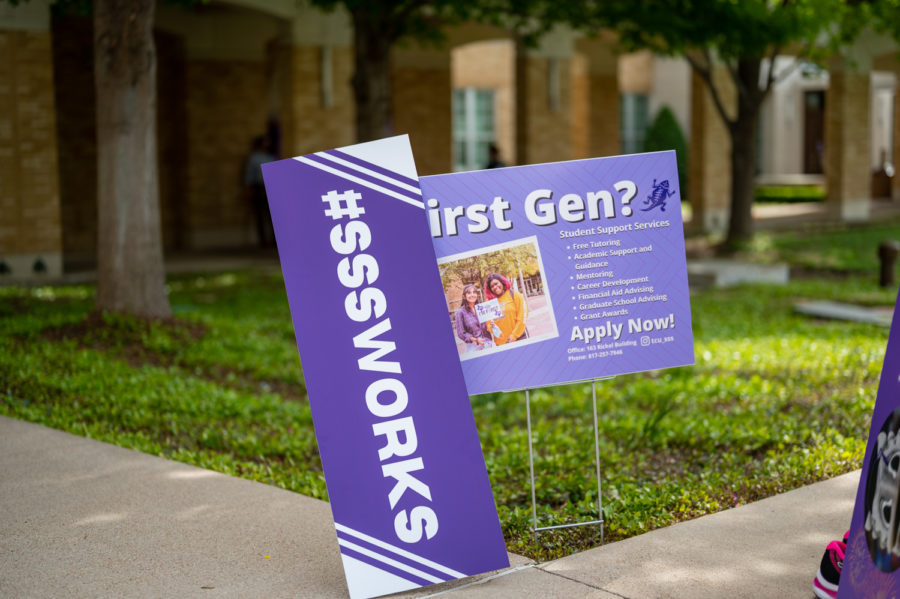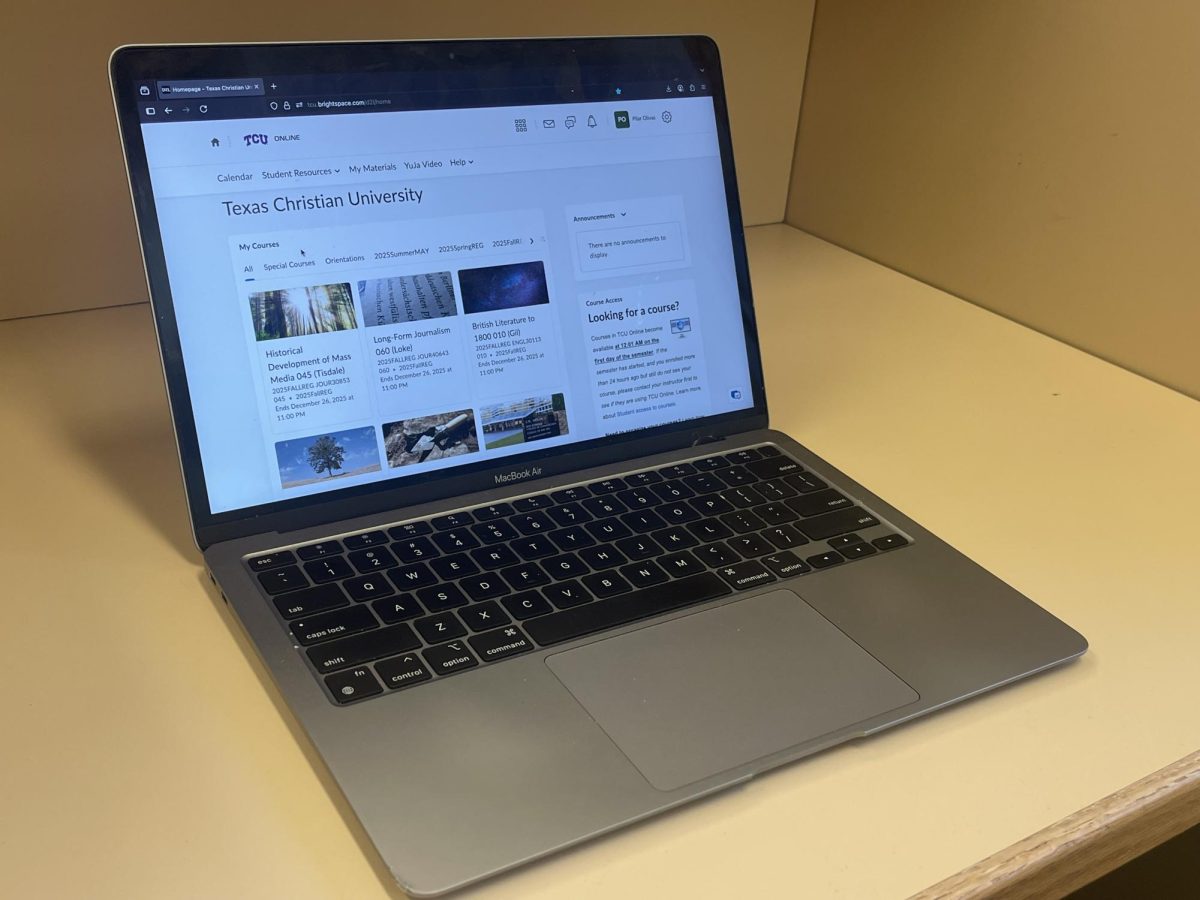The license plates in the TCU parking lots keep getting more diverse.
Over the past few years, the number of incoming students from outside of Texas has grown tremendously, lowering the number of incoming Texans at TCU by a large margin.
“For a couple of decades, TCU has been about a 70 percent Texas — therefore 30 percent out-of-state — kind of school,” Ray Brown, TCU dean of admission, said. “In the last five years, I don’t even want to say creeping down, it has sort of been plummeting.”
In fall 2008, the percentage of in-state students entering TCU was 72.9 percent. Four years later, that number dipped below 50 percent for the first time since 1979 and only the second time in school history.
That percentage dropped again this year.
“This class that is coming in is going to be about 45 percent Texans, so we know that we not only need to tap the brakes on this, we pretty much need to slam them on,” Brown said.
For the TCU Office of Admissions, the numbers are staggering to say the least.
“You might not think that 70 percent to 45 percent is much of a drop but for us to experience that in five years is more than what many admissions folks would experience in a career,” Brown said. “It is a precipitous drop.”
The Change
After being asked to pinpoint one event that created this sudden change in the admissions landscape, Brown mentioned the obvious choice: TCU football’s victory in the 2011 Rose Bowl.
First-year accounting major Mary Catherine Gagliano credited the Rose Bowl season as how she first found out about TCU. Growing up in a family of Auburn fans, she couldn’t help but notice that the Horned Frogs were closing in on the eventual national champions.
“Because my family was so involved in watching football that season for Auburn, I, too, watched a lot of football,” Gagliano wrote in an e-mail. “I remember the exact moment [I first heard about TCU]: I was looking at the Associated Press Top 25 poll to see what the rankings were, and I noticed TCU was ranked #3, and I thought to myself, ‘What is this little tiny school from Texas, and how are they ranked #3 in the nation?’”
Gagliano said she finds it funny that she’s now planning on attending that “little tiny school from Texas.”
Brown was quick to point out that the Rose Bowl was not the only reason for TCU’s rise though. Brown said he believes the Rose Bowl win merely gave exposure to an already great university.
“It’s not like that is happening in isolation,” Brown said. “That is happening with the rest of what’s going on at this really terrific place that has just zoomed in popularity [and selectivity].”
First-year entrepreneurial management major Alex Sborov said that TCU's campus is what truly stuck out to her.
“TCU’s beauty captured my attention,” Sborov, who currently lives in Pleasanton, Calif., said. “[The university] has a very fresh and new look as opposed to some of the older looking universities in California.”
Brown agrees that the campus sets TCU apart, not only from universities in other states, but also from other private schools in Texas.
“A lot of students, as you might guess, apply to the three private schools: Baylor, SMU and TCU,” Brown said. “On paper we look a lot alike, and it’s not until you get on the ground that you can start appreciating some of the differences– and there are significant differences between the three schools.”
Students
When analyzing admissions statistics, it is very easy to forget that those numbers represent actual people.
To get an idea of who the statistics actually are, a request was made on the TCU Class of 2017 Facebook page in order to reach out to some of the incoming “out-of-staters” who are expected to represent 55 percent of their class next year.
The response was overwhelming.
Since last week, 38 incoming freshmen have expressed interest in detailing some of their experiences as out-of-state students.
Among them was communication studies major Katie Phillips from Pebble Beach, Calif. Phillips who said she decided to attend TCU in order to get away from the struggling California public school system.
“First and foremost, I knew I needed to stay away from public California schools,” Phillips wrote in an e-mail. “California's public school systems are in a great amount of debt and are struggling to provide an affordable and efficient education to its students.”
Brown noted that the number of incoming Californians to TCU has skyrocketed over the past few years, particularly since Fall 2008.
“California, that year, moved into our number two state in the country with 63 freshmen,” Brown said. “This year, we are expecting 315.”
Brown said he believes that the same struggles Phillips previously mentioned are benefitting not just TCU, but other schools in the nation as well.
“California is a lot of schools’ number two state. It’s not just TCU,” Brown said. “California kids can’t get into their own schools. We’re talking kids with 4.0s.”
Phillips said she concluded that going to school in Texas would give her a greater chance of success.
“I discovered that Texas is one of the top places to live after graduation, and that Texas schools, both public and private, are well-endowed and are able to provide a great education to their students,” Phillips wrote. “Therefore, I settled on Texas and honestly, TCU was just the perfect fit. Small, but not suffocating, and well-endowed, but not superficial.”
First-year accounting major Krystyn Miner, who currently lives in Roaring Brook Township, Pa., said that going to TCU has gotten a lot of attention from her community.
“At my graduation, the superintendent announced four or five schools that he was impressed to have students accepted at and TCU was one announced among Johns Hopkins and Barnard,” Miner wrote. “I chose TCU over The University of Richmond and Rhodes College.”
Phillips and Miner represent only a small portion of the many “out-of-staters” that sent e-mails explaining their situations. Below is a map detailing most of the “out-of-staters”, where they are from and how they found out about TCU.
View Out-of-State Students in a larger map
Future Goals
While the rising number of out-of-state students is certainly seen as a good thing, the TCU Office of Admissions considers it only one of several goals they hope to eventually achieve.
“When I got here in 2000, we established four goals: we wanted more out-of-state students, more students of color, more men [and] more high achievers,” Brown said. “We feel like we’ve finally reached one of [the four goals].”
Brown also hopes to one day have all TCU classes represent every state in the US.
“We have some states that aren’t represented in every class,” Brown said. “Almost every class has almost all 50 states represented but it would sure be nice if we had every state represented in every class.”
Brown would also like the number of international students at TCU to increase. According to Brown, this incoming class is expected to have about 3 percent international students.
“I’d like to have a class of 7 or 8 percent international students,” Brown said. “Why? Because of the enhancements to your education that they would offer.”
With all the changes coming to TCU, Brown said the TCU Office of Admissions would like to bring the number of incoming Texans back up to around the 50 percent range in order to not change the essence of what TCU is.
“You ever heard the phrase ‘You dance with the one who brought you?’” Brown said. “We want to dance with the ones who brought us and those are Texans.”
Brown mentioned the reasoning behind this was to keep Texans from feeling uncomfortable and thinking that Texas Christian University had turned its backs on them.
“There are two schools in Texas, Rice and SMU, and one of them takes great pride in saying how few Texans they have. That doesn’t sit real well with really anybody,” Brown said. “It shouldn’t sit well with out-of-staters who think, ‘My gosh you’re sort of contemptuous of your roots. Are you?’ We’re not at all.”
Brown said he ultimately hopes to see the diversity of TCU increase in more than just a geographical sense.
“Even though we are, sort of, where we want to be [in regards to] in-state/out-of-state, doesn’t mean the mix is where we want it to be,” Brown said.
According to the TCU Fact Book, 40.6 percent of the fall 2012 TCU students were male.
The TCU Fact Book also says that in fall 2008, 73.1 percent of the students were white. Four years later, that percentage remained largely unchanged at 73.3 percent.
“Do we like the different license plates in the parking lot? Sure. They’re colorful. They’re fun,” Brown said. “If we’re getting students from fill-in-the-blank state who are just like Texans [though], well, then what have we really gained other than that different license plate?”







